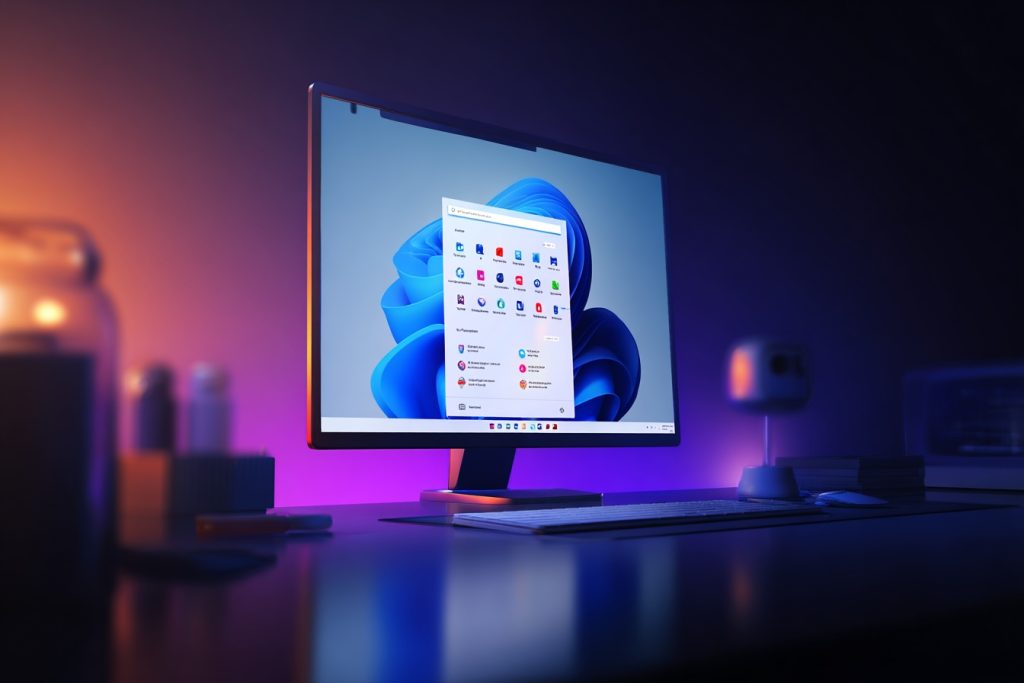
Table of Contents
Windows 11 review reveals a fascinating contradiction four years into its existence. Microsoft’s flagship operating system has evolved from a controversial redesign into something approaching maturity, yet it still carries the weight of decisions made decades ago. With Windows 10 officially reaching its end of life phase in October 2025, millions of users face a question they’d rather not answer: is upgrading to Windows 11 actually worth it?
The answer, unsurprisingly, is complicated. Windows 11 has improved substantially since its rocky 2021 launch, adding features that genuinely matter while simultaneously doubling down on AI integration that feels more obligatory than revolutionary. It’s a modern operating system trapped in a legacy body, sporting a sleek outfit over infrastructure that still bears Windows Vista’s DNA.
Windows 11 Review: The Fluent Design Philosophy Works Until It Doesn’t
Microsoft’s Fluent Design language represents the company’s most coherent visual direction in years. The centered Start menu, rounded corners, and translucent effects deliver a contemporary aesthetic that makes Windows 10 look dated by comparison. According to TechRadar’s updated assessment, these changes go beyond surface-level polish. The Start menu has genuinely become more useful, with grid views, device integration, and improved app organization that actually enhances daily workflows.
But dig deeper and the illusion fractures. Right-click menus still summon Windows 10 properties dialogs wearing only the thinnest disguise of modernity. Legacy control panels lurk beneath contemporary settings screens. It’s renovation, not reconstruction, and the seams show everywhere once you know where to look.
The inconsistency extends to Microsoft’s own applications. Paint, Notepad, and File Explorer received meaningful updates with tabs, dark modes, and modernized interfaces. Yet Calculator and Weather remain frozen in the previous generation’s design language. It’s the kind of half-finished homework that undermines confidence in Microsoft’s commitment to the platform’s future.
Copilot: The AI Nobody Asked For, Everywhere
Microsoft’s aggressive Copilot integration represents the company’s bet on artificial intelligence as the next computing paradigm. The problem? That bet arrives before the technology justifies the investment. Copilot appears in Windows 11’s taskbar, applications, and now even an “AI Hub” in the Microsoft Store, offering assistance that ranges from occasionally helpful to consistently confused.
In testing scenarios, Copilot struggled with basic document grammar checks and generated spreadsheets riddled with errors. As an accessibility tool for screen reading, it shows promise. As a productivity multiplier, it remains experimental at best, gimmicky at worst. Microsoft seems determined to make AI central to Windows 11’s identity before establishing why users should care.
The accessibility applications deserve particular attention. While AI-powered captioning and enhanced Narrator features demonstrate genuine utility for users with disabilities, Microsoft hasn’t fully capitalized on AI’s potential here. The infrastructure exists for transformative accessibility improvements, but the execution feels cautious, incremental rather than revolutionary.
Gaming Finally Gets Serious Treatment
Windows 11’s gaming credentials represent one of Microsoft’s clearest success stories. The redesigned Xbox app integrates game libraries, social features, and Xbox Game Pass subscriptions into a coherent experience that actually works. Game Bar evolved from a screenshot tool into a comprehensive overlay with performance monitoring, audio controls, and capture functionality that rivals third-party solutions.
Microsoft’s upcoming collaboration with Asus on the ROG Xbox Ally handheld, launching later in October 2025, signals where the company’s gaming ambitions point. The “Xbox Full-Screen Experience” interface, designed specifically for smaller screens and controller input, acknowledges Windows 11’s longstanding awkwardness on non-traditional form factors. That this interface won’t arrive until a 2026 update reveals both Microsoft’s gaming commitment and its persistent timing problems.
The handheld push matters beyond niche enthusiasts. Valve’s Steam Deck proved demand exists for portable PC gaming, and its SteamOS threatens Windows’ gaming monopoly. Microsoft’s response, while late, at least appears substantive. Whether it arrives soon enough remains uncertain, particularly as devices like the Lenovo Legion Go S continue pushing Android-based alternatives into gaming territory.
The Features That Actually Matter
Beyond headline additions, Windows 11 includes quality-of-life improvements that demonstrate Microsoft listened to user feedback. Multi-monitor support received substantial upgrades, with taskbars now displaying time, date, and notification centers on secondary displays. Snap Groups intelligently organize windows across screen sections. Support for .7z and .RAR compression formats joins the ancient ZIP standard.
Smaller touches matter too. Scrolling over the taskbar volume icon to adjust sound levels eliminates unnecessary clicks. Virtual Desktops support custom backgrounds and instant switching between workspace configurations. HDR support extends to compatible monitors. These aren’t revolutionary features, they’re refinements that accumulate into meaningful workflow improvements.
The Microsoft Store transformation deserves recognition. After years as a wasteland of low-quality ports and abandoned storefronts, the redesigned Store in Windows 11 finally delivers a browsing experience that doesn’t inspire immediate abandonment. Finding and installing applications feels intuitive rather than punishing. For users migrating from Windows 10’s end of life deadline, this represents one of the most visible improvements.
The Pricing Problem

Windows 11 remains free for Windows 10 users meeting system requirements, which sounds generous until examining those requirements. Microsoft’s controversial TPM 2.0 and processor generation restrictions excluded perfectly capable hardware from official upgrade paths. Users face either accepting their devices as obsolete or purchasing new hardware to access free software.
For fresh installations, Windows 11 Home costs $119 in the United States, £119 in the UK, and AU$249 in Australia. The Pro version adds BitLocker encryption and enterprise features most consumers don’t need at $99 for upgrades or £219 for full UK licenses. Third-party encryption tools like VeraCrypt provide similar functionality without the premium, making Pro’s value proposition questionable for home users.
What Windows 11 Gets Right, And Wrong
Windows 11 succeeds as an incremental improvement over Windows 10. Its design language feels contemporary, gaming integration approaches comprehensive, and quality-of-life features accumulate into genuine value. The operating system runs stably, receives regular updates, and supports modern hardware effectively.
But incremental improvement wasn’t Microsoft’s 2021 promise. Windows 11 launched as transformation, a clean break from Windows’ accumulated cruft. Four years later, it remains an evolution wearing revolution’s clothing. Legacy interfaces persist, AI integration feels premature, and the system requirements controversy continues alienating users with functional hardware.
The comparison to Apple’s approach reveals different philosophies. While macOS Tahoe introduces its own controversial Liquid Glass design, Apple maintains cohesive aesthetics across system applications. Microsoft’s inconsistent modernization creates an operating system that feels perpetually half-updated, always one release away from completion.
Should You Upgrade?
For Windows 10 users approaching the October 2025 end of life deadline, upgrading makes practical sense despite Windows 11’s compromises. Security updates matter more than aesthetic complaints, and the alternative involves either paying for extended Windows 10 support or accepting unpatched vulnerabilities.
For users satisfied with alternative operating systems, Windows 11 doesn’t present compelling reasons to switch. Its advantages over macOS or Linux distributions remain largely about software compatibility and gaming support, traditional Windows strengths rather than new innovations.
Windows 11 represents Microsoft’s current best effort at balancing legacy support with modern expectations. That it succeeds more often than it fails speaks to the difficulty of that challenge. But “better than Windows 10” sets a remarkably low bar for an operating system meant to define Microsoft’s next decade.
The question isn’t whether Windows 11 works. It does. The question is whether it works well enough to justify the compromises Microsoft demands. For most users, particularly those forced to upgrade, the answer comes down to accepting imperfection as the price of continued support.